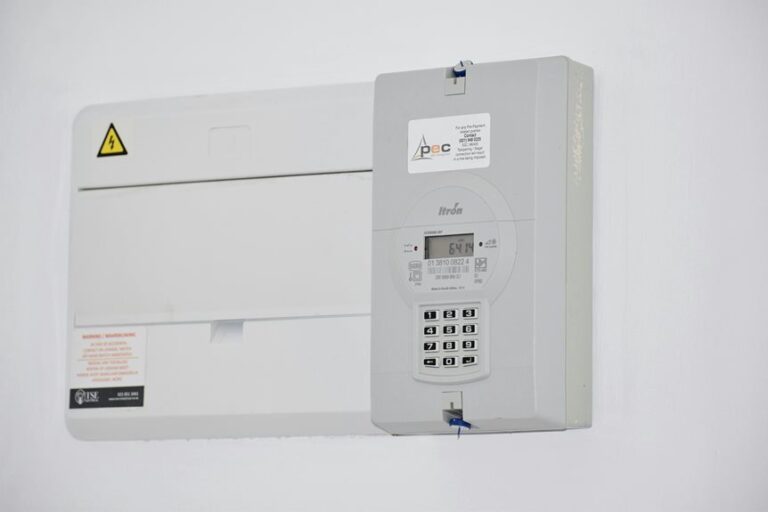Did you know that businesses can reduce their energy costs by up to 30% through effective energy management strategies? You're likely aware that optimizing energy consumption is not just about cutting costs; it's also about enhancing operational efficiency and meeting regulatory demands. By understanding your energy usage patterns and employing advanced technologies, you can uncover significant opportunities for improvement. However, the challenge lies in knowing where to start and how to sustain these changes over time. What specific strategies can you implement to drive this optimization?
Importance of Energy Management
In today's fast-paced world, effective energy management is essential for both economic and environmental sustainability. You must recognize that energy management isn't merely a trend; it's a critical strategy that can lead to significant cost savings and enhanced operational efficiency.
By implementing energy management practices, you can optimize resource allocation and reduce unnecessary expenditures, directly impacting your bottom line.
Moreover, energy management contributes to environmental sustainability by minimizing greenhouse gas emissions. When you adopt energy-efficient technologies and practices, you not only lower your energy consumption but also decrease your carbon footprint.
This dual benefit—economic savings and environmental stewardship—strengthens your organization's reputation and compliance with regulatory standards.
Furthermore, by utilizing data analytics and monitoring systems, you can gain real-time insights into your energy usage patterns. This information allows you to make informed decisions, enabling proactive adjustments to energy consumption.
As a result, you can enhance performance and adapt to the ever-changing energy landscape.
Understanding Energy Consumption
Understanding how energy is consumed within your organization is fundamental to effective energy management. You need to analyze consumption patterns across various departments, equipment, and processes to identify where energy is being used most intensively.
Start by gathering data from utility bills, sub-metering systems, and energy management software to create a thorough overview of your energy usage.
Employing energy audits can help pinpoint inefficiencies and highlight opportunities for improvement. Break down energy usage by time of day and operational activities to understand peak consumption periods. This level of detail allows you to correlate energy usage with operational performance, enabling you to make informed decisions.
Consider the role of specific equipment and processes in your energy consumption profile. For instance, HVAC systems, lighting, and manufacturing machinery often represent significant portions of total energy use.
Understanding their operational schedules and energy requirements helps you identify critical areas for intervention.
Key Energy Efficiency Strategies
Implementing key energy efficiency strategies can greatly reduce operational costs and enhance sustainability. First, you should conduct an energy audit to identify inefficiencies in your systems. This assessment highlights areas where energy is wasted, allowing you to prioritize improvements.
Next, consider upgrading to energy-efficient lighting, such as LED fixtures, which consume less energy and have longer lifespans. Installing smart thermostats can also optimize heating and cooling by adjusting settings based on occupancy and time of day.
You must also focus on equipment maintenance; regular servicing can improve efficiency and prolong the life of your appliances. Implementing variable frequency drives (VFDs) on motors can further enhance efficiency by adjusting motor speed to match the load requirements.
Encouraging employee engagement in energy-saving practices is essential. Conduct training sessions to raise awareness about energy conservation techniques.
Finally, consider engaging with renewable energy sources, such as solar panels, to supplement your energy needs and reduce reliance on grid power.
Technologies for Monitoring Usage
To effectively manage electrical energy, you need to leverage smart metering solutions that provide accurate usage data.
Integrating real-time data analytics enables you to monitor consumption patterns and make informed decisions.
Additionally, IoT integration offers significant benefits by connecting devices, enhancing efficiency, and streamlining energy management processes.
Smart Metering Solutions
Smart metering solutions have revolutionized the way we monitor and manage electrical energy usage. These advanced devices provide real-time data on energy consumption, allowing you to identify patterns and optimize usage effectively.
By integrating smart meters into your energy management system, you gain access to granular data that helps in pinpointing inefficiencies and reducing costs.
The technology works by utilizing two-way communication between the meter and your energy provider. This enables automatic readings and eliminates the need for manual meter checks.
You can access detailed consumption data via a user-friendly interface, which allows for precise tracking of energy usage across different times and zones.
Smart meters also support demand response initiatives, providing you with the capability to adjust your consumption based on real-time pricing signals. This flexibility can lead to significant savings during peak periods.
Additionally, many smart metering solutions are compatible with other energy management systems, allowing for seamless integration and enhanced operational efficiency.
Real-Time Data Analytics
With the integration of smart metering solutions, real-time data analytics has become a game changer in monitoring electrical energy usage. You can now access instantaneous data that allows you to make informed decisions about your energy consumption. By leveraging data analytics, you can identify patterns, detect anomalies, and optimize your energy usage effectively.
Here's a concise overview of how real-time data analytics enhances your energy management:
| Feature | Benefit | Example |
|---|---|---|
| Instant Data Access | Immediate insights for action | Spotting peaks in usage |
| Anomaly Detection | Identifies irregular patterns | Detecting equipment failure |
| Usage Forecasting | Predicts future consumption | Planning for seasonal changes |
Utilizing real-time analytics not only helps in cutting costs but also improves operational efficiency. You'll find that by monitoring usage patterns, you can implement strategies to reduce waste and enhance overall energy performance. In a competitive landscape, this proactive approach will position you to stay ahead, ensuring that you're not just reacting to energy needs but anticipating them effectively.
IoT Integration Benefits
Integrating IoT technologies into energy management systems revolutionizes how you monitor and optimize energy usage. These technologies provide real-time insights, enabling you to track energy consumption patterns and identify anomalies quickly.
By employing smart sensors and connected devices, you gain granular visibility into your energy footprint, allowing for more informed decision-making. One significant benefit is predictive analytics, which uses historical data to forecast future energy needs. This capability helps you optimize resource allocation and reduce wastage.
Additionally, IoT integration facilitates automated adjustments to energy consumption based on demand, ultimately leading to cost savings and increased operational efficiency.
Moreover, remote monitoring capabilities enable you to oversee multiple sites simultaneously, which is particularly advantageous for businesses with multiple locations. You can receive alerts for irregularities, allowing for prompt action and minimizing downtime.
Finally, integrating IoT technologies enhances sustainability efforts. You can track and analyze your carbon footprint, aligning your operations with environmental goals.
To summarize, the benefits of IoT integration in energy management extend far beyond just monitoring; they provide an all-encompassing framework for improving efficiency, reducing costs, and promoting sustainability in your energy usage.
Role of Renewable Energy
Renewable energy sources, such as solar, wind, and hydroelectric power, play a pivotal role in modern electrical energy management. By integrating these resources into your energy strategy, you can enhance efficiency, reduce costs, and minimize environmental impacts.
Solar energy systems, for instance, allow you to harness sunlight, converting it into electricity through photovoltaic cells. This not only lowers your reliance on fossil fuels but also stabilizes energy costs over time.
Wind power contributes considerably, utilizing turbines to convert wind kinetic energy into electricity. By situating wind farms strategically, you can optimize energy production and improve grid resilience.
Hydroelectric power, generated from flowing water, offers a reliable and consistent energy source, often serving as a baseload supply.
Incorporating these renewable sources requires advanced energy management systems. These systems facilitate real-time monitoring and analytics, enabling you to adjust energy consumption patterns based on availability and demand.
Additionally, integrating energy storage solutions, like batteries, allows you to store excess energy produced during peak generation times, ensuring you have a steady supply when needed. By embracing renewables, you're not only future-proofing your energy strategy but also contributing to a sustainable energy ecosystem.
Regulatory Compliance and Standards
Maneuvering the landscape of electrical energy management necessitates strict adherence to regulatory compliance and standards.
These regulations guarantee safety, promote efficiency, and help you avoid costly penalties. It's vital to stay informed about the relevant standards that apply to your operations.
Here are four key areas you need to focus on:
- National Electric Code (NEC): This code governs electrical installations and safety across the U.S., guaranteeing that your systems are safe and reliable.
- Energy Policy Act (EPAct): This legislation encourages energy efficiency and renewable energy use, impacting your energy management practices.
- ISO 50001: This international standard provides a framework for establishing energy management systems, helping you improve energy performance.
- Occupational Safety and Health Administration (OSHA) Regulations: Compliance with OSHA guarantees worker safety during electrical operations, minimizing risks and liabilities.
Implementing Energy Audits
Implementing energy audits is essential for identifying inefficiencies and optimizing electrical energy use within your operations.
You'll discover the benefits of these audits, such as cost savings and enhanced regulatory compliance, while also understanding the key steps involved in conducting a thorough assessment.
Benefits of Energy Audits
Energy audits serve as an essential tool for organizations aiming to enhance their operational efficiency and reduce costs. By systematically evaluating energy use, you can identify inefficiencies and implement targeted solutions that lead to significant benefits.
Here are four key advantages of conducting energy audits:
- Cost Savings: By identifying high-energy consumption areas, you can implement strategies to lower utility bills. This often leads to immediate financial relief.
- Improved Operational Efficiency: A detailed analysis can reveal operational bottlenecks or outdated systems, enabling you to streamline processes and enhance overall productivity.
- Regulatory Compliance: Energy audits help guarantee compliance with local and national regulations, reducing the risk of fines or penalties associated with non-compliance.
- Sustainability Goals: Conducting an energy audit aligns with corporate sustainability initiatives. By reducing energy consumption, you contribute to environmental conservation and improve your organization's public image.
Embracing energy audits not only facilitates informed decision-making but also positions your organization as a leader in energy management, paving the way for a more sustainable and cost-effective future.
Key Audit Steps
Conducting a successful energy audit involves several key steps that guarantee a thorough evaluation of your facility's energy use.
First, initiate by defining the audit scope and objectives. Determine what areas you want to focus on—lighting, HVAC systems, or machinery.
Next, gather historical energy consumption data to establish a baseline for analysis. This data will help you identify trends and anomalies in your energy usage.
After you've collected the necessary information, conduct a walkthrough of your facility. Observe equipment operation, maintenance practices, and occupancy patterns. This hands-on assessment will provide insights into potential energy-saving opportunities.
Following the walkthrough, utilize energy modeling software to analyze the data. This step allows you to simulate different energy scenarios and prioritize improvement measures based on cost-effectiveness and return on investment.
Finally, compile your findings into a detailed report. Include actionable recommendations and prioritize them based on impact and feasibility.
Present this report to stakeholders, ensuring they understand the benefits of suggested measures. By following these key steps, you'll not only enhance your facility's energy efficiency but also contribute to overall sustainability goals.
Employee Engagement in Energy Savings
Many organizations recognize that fostering employee engagement in energy savings is essential for achieving sustainability goals. Engaging employees not only creates a culture of responsibility but also drives measurable results.
To effectively implement an energy-saving initiative, consider the following strategies:
- Training Programs: Conduct regular training sessions to educate employees about energy-efficient practices and the impact of their actions on energy consumption.
- Incentive Systems: Develop incentive programs that reward employees for innovative energy-saving ideas or for achieving specific energy-reduction targets.
- Feedback Mechanisms: Establish channels for employees to provide feedback on energy management practices, ensuring they feel valued and involved in decision-making processes.
- Visibility of Results: Share energy consumption data and savings achieved through employee efforts, reinforcing the positive impact of their contributions.
Future Trends in Energy Management
As organizations embrace employee-driven initiatives for energy savings, they must also anticipate the evolving landscape of energy management. Emerging technologies such as artificial intelligence and machine learning are set to revolutionize how you monitor and optimize energy use. These tools enable predictive analytics, allowing you to forecast energy demand and adjust your consumption patterns proactively.
Moreover, the integration of the Internet of Things (IoT) will facilitate real-time data collection from smart meters and connected devices. This connectivity not only enhances visibility into energy usage but also enables automatic adjustments based on occupancy and operational needs.
Sustainability regulations and corporate responsibility are also pushing you toward renewable energy sources. By investing in solar and wind technologies, you can reduce reliance on fossil fuels while potentially lowering operational costs.
Additionally, energy management systems (EMS) will become more sophisticated, offering extensive dashboards that provide insights into energy performance. This level of granularity will empower you to make informed decisions and drive continuous improvement in energy efficiency.
Ultimately, staying ahead of these trends will be essential for enhancing your organization's energy management strategy, fostering both financial and environmental sustainability.
Conclusion
To summarize, effective electrical commercial energy management isn't just a choice—it's a necessity for thriving in today's competitive landscape. By adopting smart strategies and engaging your team, you can uncover hidden efficiencies that not only cut costs but also greatly reduce your environmental footprint. Imagine the impact on your bottom line and reputation. As you move forward, the question looms: Are you ready to embrace the future of energy management and lead the charge toward sustainability?








